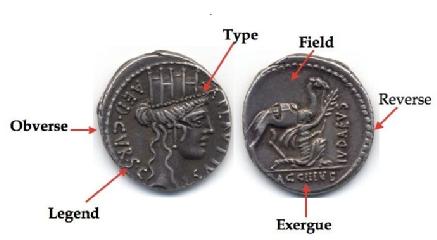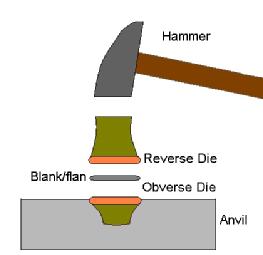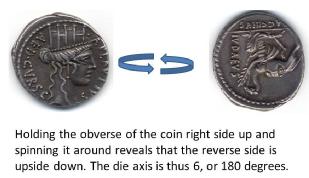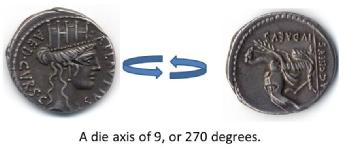Glossary of Terms
| G (no definitions) | I (no definitions) | J (no definitions) | ||||||||||
| U (no definitions) | W (no definitions) | X (no definitions) | Y (no definitions) | Z (no definitions) |
A
- A coin and its parts
-

There is a specific terminology used by numismatists when describing a coin. Type refers to the image on a coin. The legend is any writing on the coin. The exergue is a space on the coin below the central design, usually delineated by a line. The field of a coin is the blank space surrounding the image. The obverse of a coin is usually the 'heads' side, though technically it is the side of a coin struck from the die placed in the anvil during coin production. The reverse is normally the 'tails' side, or the side struck from the die held by a mint worker.
- AE
A numismatic abbreviation for copper or bronze, from the Latin word aes.
- ancile
A divine shield, whose survival ensured continuing Roman power.
- apex
A round or conical hat with a wooden pointed piece of wood on top, worn by Roman priests (pontifex maximus and flamines).
- aquila
A Roman legionary standard.
- AR
Numismatic abbreviation for silver.
- as
A Roman bronze coin denomination (plural asses).
- aspergillum
An instrument used to sprinkle holy water, associated with Roman priests.
- AU
Numismatic abbreviation for gold.
- aureus
A Roman gold coin.
B
- BI
Numismatic abbreviation for billon (a heavily debased silver).
- biga
A chariot of two horses.
- bipennis
A double-bladed axe.
C
- caduceus
A staff associated with Hermes and heralds.
- carnyx
A type of trumpet associated with Celtic populations in Gaul and Britain.
- cista
A chest, this item was associated in the with the position of moneyer or quaestor. The cista mystica was used to house snakes, and was associated with the religious cult of Dionysius.
- coin striking

In antiquity coins were often produced by hand, and this process could result in imperfections. Coins were either cast, or (more commonly) struck using two dies.The obverse die was placed in an anvil, while the reverse die was held by the mint worker. A prepared piece of metal of appropriate weight (flan) was then placed between the two dies and struck.
- cornucopia
A symbol of abundance, a horn-shaped vessel overflowing with fruits or other produce.
- countermark
A stamped mark added to a coin after it had originally been struck.
- culullus
A vessel associated with the Vestal Virgins and Roman priests.
- curule chair
Also known as the sella curulis, this was the chair upon which Roman magistrates sat.
D
- denarius
A Roman silver coin, minted from 211 BC.
- die
A metal stamping tool engraved with the negative of a design, from which the positive image is transferred to the coin blanks during minting. The obverse die was placed in an anvil, while the reverse die was held by the mint worker.
- die axis
This is the relative positioning of the obverse and reverse designs. This is calculated by holding a coin with the obverse the correct side up, and then spinning the coin around to examine the orientation of the reverse. Die axes can be expressed in degrees, or by using a clock analogy (12 o'clock, 9 o'clock, etc). The clock analogy is used within this database. If obverse and reverse designs align perfectly (as on modern coinage), the die axis is 12. If, when the coin is rotated, the image is upside down, then the die axis is 6.


E
- EL
Numismatic abbreviation for electrum.
- exergue
a space on the coin below the central design, usually delineated by a line
F
- falcata
An sword typically found on the Iberian Peninsula.
- fasces
A bundle of rods, often with an axe. A symbol of the authority of Roman magistrates or other officials.
- field
the blank space on a coin surrounding the image
- flan
The preprepared metal disc onto which the coin design was struck.
H
- harpa
A sickle, associated with Neptune.
K
- kernos
A type of Greek pot which has several smaller vessels attached to it for offerings.
L
- lagobolon
A hunter's stick for striking hares.
- laureate
Wearing a laurel wreath.
- legend
The writing on a coin.
- lemniskos
A ribbon or band.
- lituus
The curved staff of an augur (a Roman religious office).
M
- modius
a Roman unit of measurement, used for measuring grain.
- moneyer
The ancient official responsible for coin production. In Republican Rome, this was normally an annual position given to three men, who were called the tresviri monetales (IIIVIR). In other cities, however, the title could differ.
- monogram
A figure which joins together several letters so they appear as one.
N
- numismatics
The study of currency.
O
- obverse
usually the 'heads' side of the coin, though technically it is the side of a coin struck from the die placed in the anvil during coin production
- Or
Numismatic abbreviation for Orichalcum (brass).
P
- patera
A bowl used for libation.
- pedum
A shephard's crook.
- pharos
lighthouse
- pileus
A cap associated with the manumission of slaves and freedom or liberty.
- pilum
A javelin commonly used in the Roman army.
- praefericulum
a metal vase used by the Roman augurs and priests.
- principate
A term used to refer to the Roman Empire and its mode of government, derived from the term for the emperor, princeps, meaning 'first citizen'.
Q
- quadrans
A Roman coin worth one quarter of an as.
- quadriga
A chariot of four horses.
- quaestor
A Roman official in charge of financial affairs.
R
- radiate
Radiate means wearing a radiate crown. A radiate crown was originally the crown of Sol. Under Nero, however, the radiate crown was used on coinage to signal a 'double denomination', i.e. that something was worth 'two' (e.g. dupondius, antoninianus).
- reverse
normally the 'tails' side of a coin, or the side struck from the die held by a mint worker.
- rostrum
The ram placed on the front of a ship.
S
- saltire
a diagonal cross or X
- S C
A Latin abbreviation for senatus consultum, meaning the 'decree of the Senate'. The abbreviation normally refers to coins struck by decree of the Senate, though this is not always the case.
- semis
A Roman bronze coin valued at half an as.
- sextans
A bronze coin denomination valued at one sixth of an as.
- simpulum
A vessel with a long handle used to make libations; a symbol of a Roman priest.
- skyphos
A vessel used for drinking wine.
- SNG
An abbreviation which refers to the published catalogues of Greek coins known as the Sylloge Nummorum Graecorum.
T
- taenia
A flat band.
- torque
A metal neck ring, worn as jewellery.
- triskeles
A symbol consisting of three bent human legs.
- triumvirate
During the late Republic, the term triumvirate is given to the political alliance and agreement made between major Roman politicians. The first triumvirate was formed between Julius Caesar, Pompey and Crassus (60-53 BC); the second was formed between Octavian, Lepidus and Marc Antony (43-33 BC).
- type
The image on a coin.
V
- vexillum
A flag-like standard.
